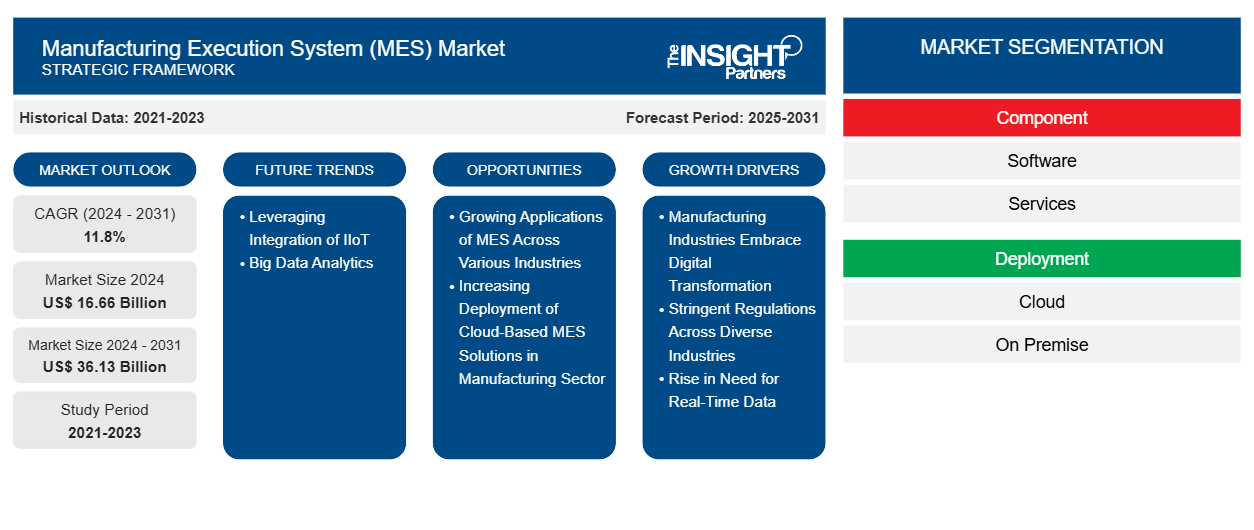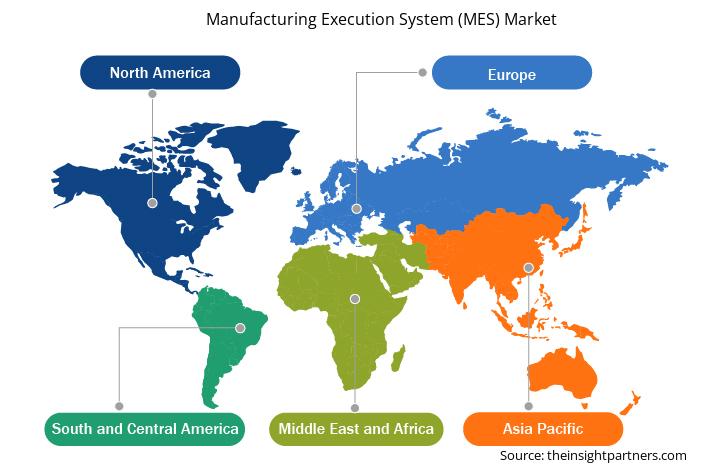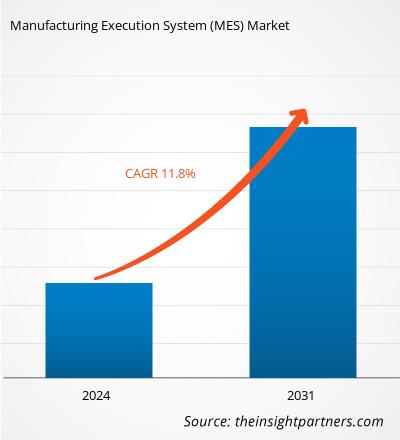製造実行システム (MES)の市場規模は、2024 年に 166.6 億米ドルと評価され、2031 年までに 361.3 億米ドルに達すると予想されています。2024 年から 2031 年にかけて 11.8% のCAGRを記録すると予測されています。IIoT とビッグデータ分析の統合を活用することは、引き続き主要な市場トレンドとなると思われます。
製造実行システム (MES) 市場分析
製造業がデジタル変革に乗り出していること、さまざまな業界での厳しい規制、リアルタイムデータのニーズの高まりなどの要因が、製造実行システム(MES)市場の成長を牽引しています。さまざまな業界でのMESの使用の増加と、製造におけるクラウドベースのMESソリューションの台頭により、製造実行システム(MES)市場の拡大の機会が生まれると予想されます。さらに、IIoTとビッグデータ分析の統合を活用することで、製造実行システム(MES)市場に新たなトレンドが生まれると予想されます。
製造実行システム (MES) 市場の概要
製造実行システム (MES) は、原材料から完成品まで、製造プロセス全体を監視、追跡、文書化、管理する包括的で動的なソフトウェア システムです。MES は、エンタープライズ リソース プランニング ( ERP ) とプロセス制御システム間の機能レイヤーとして機能し、意思決定者に工場現場の効率性を向上させるために必要なデータを提供します。MES を使用すると、企業は原材料の受け入れから完成品の配送まで、製造プロセス全体を追跡および制御できます。これには、作業指示の処理、製品品質の確認、機械のパフォーマンスの監視、および製造プロセス全体のデータ収集が含まれます。
MES ソフトウェアは、原材料を中間製品や完成品に変換する際のリアルタイムの物理プロセスと人員を管理、監視、調整するために使用されます。さらに、製造の意思決定者が生産量を増やすために工場の稼働条件を最適化する方法を理解するのに役立つ実用的なデータを提供します。MES ソフトウェアは、PLM、ERPシステム (IT)、および機械 (OT) 間の橋渡しとして機能します。このソフトウェア レイヤーにより、生産プロセスの効率と品質が向上し、生産性と収益性が向上します。
要件に合わせてレポートをカスタマイズする
このレポートの一部、国レベルの分析、Excelデータパックなど、あらゆるレポートを無料でカスタマイズできます。また、スタートアップや大学向けのお得なオファーや割引もご利用いただけます。
製造実行システム (MES) 市場:戦略的洞察

-
このレポートの主要な市場動向を入手してください。この無料サンプルには、市場動向から見積もりや予測に至るまでのデータ分析が含まれます。
製造実行システム (MES) 市場の推進要因と機会
多様な業界にわたる厳しい規制
MES は、完全なトレーサビリティとデータ記録を通じて業界のコンプライアンスを確保します。製造に関与する原材料、コンポーネント、プロセス、およびオペレーターに関する広範な情報を記録します。このデータにより、メーカーは規制基準を満たし、高い基準を維持することができます。たとえば、MES は製造プロセスの各段階を自動的に文書化できるため、規制検査に必要な監査証跡が作成されます。また、品質管理パラメータをリアルタイムで分析して、製品が業界標準を満たしていることを確認します。逸脱が発生した場合、MES はアラートを送信し、コンプライアンスを確保するための是正措置を講じることができます。 MES は製薬分野の日常業務のバックボーンであり、製造プロセスのあらゆる側面を正確かつリアルタイムで管理します。製薬業界では、MES は厳格な適正製造基準 ( GMP ) 基準に従って電子バッチ記録 ( EBR ) を促進します。EBRシステムを導入することで、MES は各製造段階が正確に文書化されることを保証し、人為的ミスのリスクを軽減し、日常業務の管理を簡素化します。さらに、食品および飲料業界の MES は、危害分析重要管理点 ( HACCP ) を含むすべての法的および衛生基準を満たしています。食品および飲料業界での MES の導入は、製造プロセスの中断を最小限に抑えるために、選択した製造ラインまたはエリアから始めて段階的に行うのが最適です。このように、さまざまな業界にわたる厳格な規制基準が、製造実行システム (MES) 市場の成長を促進しています。
さまざまな業界で拡大する MES の応用
MES ソリューションは、自動車、エレクトロニクス、製薬などのさまざまな業界の特定のニーズに合わせて実装および変更できます。同時に、MES の基本的な機能はどの業界でも同じです。製造実行システム (MES) ソリューションは、ますます複雑で急速に変化する自動車業界に対応し、製造業務を市場のニーズに合わせて調整するのに役立ちます。MES は、運用管理、情報管理、統合ゲートウェイという 3 つの主要な機能を使用してこれを実現します。MES を使用すると、自動車サプライヤーは変化する業界のトレンドに遅れを取らずに済みます。自動車製造では、MES は複雑な組立ラインを調整する上で重要な役割を果たします。MES は、組立ライン上の車両の進行状況を追跡し、コンポーネントの可用性を監視し、さまざまなワークステーション間で操作を同期します。バッテリーメーカーは、混合から配合までの完全なトレーサビリティを確保することで、品質管理を改善できます。タイヤメーカーは、複雑なタイヤミックスを管理しながら、効率と品質基準を維持できます。MES は、多くの分野で定量化可能な改善を実現できます。ロックウェル・オートメーションによれば、MES はスクラップを最大 8%、リードタイムを最大 45%、サイクルタイムを最大 45%、人件費を最大 50%、不良率を最大 75% 削減できます。このため、MES はさまざまな業界で応用されています。したがって、さまざまな業界での MES の応用が拡大することで、市場の成長に有利な機会が生まれると予想されます。
製造実行システム (MES) 市場レポートのセグメンテーション分析
製造実行システム (MES) 市場分析の導出に貢献した主要なセグメントは、コンポーネント、展開、組織規模、ライセンス タイプ、販売チャネル、およびエンド ユーザーです。
- コンポーネントに基づいて、市場はソフトウェアとサービスに分割されます。サービスセグメントはさらにプロフェッショナルサービスとマネージドサービスに分割されます。2024年にはソフトウェアセグメントが市場を支配しました。
- 展開の面では、市場はオンプレミスとクラウドに分かれています。クラウドセグメントはさらにプライベートクラウド、パブリッククラウド、ハイブリッドクラウドに分かれています。2024年にはクラウドが最大の市場シェアを占めました。
- 製造実行システム (MES) 市場は、組織の規模によって、大企業と中小企業に分かれています。2024 年には大企業セグメントが市場を支配しました。
- ライセンスの種類に基づいて、製造実行システム (MES) 市場は、ライセンスベースとサブスクリプションベースに分類されます。サブスクリプションベースのセグメントは、2024 年に市場を支配しました。
- 販売チャネルに基づいて、市場は直接販売、チャネル パートナー、およびサードパーティ プロバイダーに分類されます。2024 年には直接販売セグメントが市場を支配しました。
- エンドユーザーに基づいて、市場はプロセス産業とディスクリート産業に分類されます。プロセス産業セグメントは、食品および飲料、石油およびガス、化学薬品、パルプおよび紙、化学、エネルギーおよび電力、医薬品およびライフサイエンス、水および廃水処理、その他にさらに分類されます。ディスクリート産業セグメントは、自動車、電子機器、半導体、航空宇宙および防衛、消費財、医療機器、その他にさらに細分化されます。ディスクリート産業セグメントは、2024年に市場を支配しました。
製造実行システム (MES) の地域別市場シェア分析
- 製造実行システム (MES) 市場は、北米、ヨーロッパ、アジア太平洋 (APAC)、中東およびアフリカ (MEA)、南米および中米の 5 つの主要地域に分かれています。2024 年の製造実行システム (MES) 市場は北米が支配的でした。ヨーロッパは世界の製造実行システム (MES) 市場への第 2 位の貢献者であり、アジア太平洋がそれに続きます。
- 北米の製造実行システム (MES) 市場は、米国、カナダ、メキシコに分かれています。北米は、地域の先進的な製造基盤とインダストリー 4.0 テクノロジーの早期導入により、製造実行システム (MES) 市場で大きなシェアを占めています。特に米国には、Rockwell Automation や Honeywell International Inc. などの世界的リーダーを含む多くの MES ソフトウェア ベンダーが拠点を置いています。北米での MES 導入は、自動車、航空宇宙、製薬、エレクトロニクスなどの業界で普及しています。リアルタイム データ分析、生産効率、規制遵守への重点が高まっていることから、MES ソリューションの需要が高まっています。さらに、北米の市場は、製造業者や政府当局がリアルタイムの生産監視とプロセス最適化の利点をますます認識するにつれて、大幅な成長を遂げています。さらに、デジタル変革とインダストリー 4.0 導入に対する政府のインセンティブにより、MES システムの需要が加速し、市場の成長がさらに促進されています。
製造実行システム (MES) 市場の地域別分析
予測期間を通じて製造実行システム (MES) 市場に影響を与える地域的な傾向と要因は、Insight Partners のアナリストによって徹底的に説明されています。このセクションでは、北米、ヨーロッパ、アジア太平洋、中東およびアフリカ、南米および中米にわたる製造実行システム (MES) 市場のセグメントと地理についても説明します。

- 製造実行システム(MES)市場の地域別データを入手
製造実行システム(MES)市場レポートの範囲
| レポート属性 | 詳細 |
|---|---|
| 2024年の市場規模 | 166.6億米ドル |
| 2031年までの市場規模 | 361.3億米ドル |
| 世界のCAGR(2024年 - 2031年) | 11.8% |
| 履歴データ | 2021-2023 |
| 予測期間 | 2025-2031 |
| 対象セグメント |
コンポーネント別
|
| 対象地域と国 |
北米
|
| 市場リーダーと主要企業プロフィール |
|
製造実行システム(MES)市場のプレーヤー密度:ビジネスダイナミクスへの影響を理解する
製造実行システム (MES) 市場は、消費者の嗜好の変化、技術の進歩、製品の利点に対する認識の高まりなどの要因により、エンドユーザーの需要が高まり、急速に成長しています。需要が高まるにつれて、企業は提供を拡大し、消費者のニーズを満たすために革新し、新たなトレンドを活用し、市場の成長をさらに促進しています。
市場プレーヤー密度とは、特定の市場または業界内で活動している企業または会社の分布を指します。これは、特定の市場スペースに、その規模または総市場価値と比較して、どれだけの競合相手 (市場プレーヤー) が存在するかを示します。
製造実行システム (MES) 市場で事業を展開している主要企業は次のとおりです。
- SAP SE
- ABB株式会社
- ダッソー・システムズ SE
- シュナイダーエレクトリック SE
- エマーソンエレクトリック社
- ゼネラル・エレクトリック
免責事項:上記の企業は、特定の順序でランク付けされていません。

- 製造実行システム(MES)市場のトップキープレーヤーの概要を入手
製造実行システム (MES) 市場のニュースと最近の動向
製造実行システム (MES) 市場は、主要な企業出版物、協会データ、データベースなどの一次調査と二次調査後の定性的および定量的データを収集することによって評価されます。製造実行システム (MES) 市場の動向のいくつかを以下に示します。
- Emerson Automation Solutions は、Informetric Systems Inc. とのパートナーシップを拡大したことを発表しました。Emerson は、InfoBatch を Syncade Manufacturing Execution System に統合しました。Emerson の顧客は、InfoBatch レポート スイートを使用して、Syncade、DeltaV、およびサードパーティのデータベース/ヒストリアンからデータを集約できるようになりました。
(出典:エマソン・オートメーション・ソリューションズ、プレスリリース、2024年11月)
- GE Vernova のエネルギー事業ポートフォリオの重要な一部である GE Digital は、フロリダ州オーランドで 2 月 6 日から 9 日まで開催された第 27 回年次 ARC 業界フォーラムで、Proficy Smart Factory ポートフォリオのクラウドベースの製造実行システム (MES) ソフトウェアに対する新しい機能強化を発表しました。オンプレミス実装と比較して資本支出 (CAPEX) と運用経費 (OPEX) を削減する Proficy Smart Factory クラウド MES ソフトウェアは、あらゆる規模のプロセス、ディスクリート、および混合環境メーカーが総所有コスト (TCO) を最大 30% 削減し、メンテナンスを減らし、セキュリティを向上させるのに役立ちます。
(出典:GE Digital、プレスリリース、2023年2月)
製造実行システム (MES) 市場レポートの対象範囲と成果物
「製造実行システム (MES) 市場規模と予測 (2021 ~ 2031 年)」では、以下の分野をカバーする市場の詳細な分析を提供します。
- 製造実行システム(MES)市場規模と予測(対象範囲に含まれるすべての主要市場セグメントの世界、地域、国レベル)
- 製造実行システム(MES)市場の動向、および推進要因、制約、主要な機会などの市場動向
- 詳細なPESTおよびSWOT分析
- 主要な市場動向、世界および地域の枠組み、主要プレーヤー、規制、最近の市場動向を網羅した製造実行システム(MES)市場分析
- 市場集中、ヒートマップ分析、主要プレーヤー、製造実行システム (MES) 市場の最近の動向を網羅した業界の状況と競争分析
- 詳細な企業プロフィール
- 過去2年間の分析、基準年、CAGRによる予測(7年間)
- PEST分析とSWOT分析
- 市場規模価値/数量 - 世界、地域、国
- 業界と競争環境
- Excel データセット
最新レポート
お客様の声
購入理由
- 情報に基づいた意思決定
- 市場動向の理解
- 競合分析
- 顧客インサイト
- 市場予測
- リスク軽減
- 戦略計画
- 投資の正当性
- 新興市場の特定
- マーケティング戦略の強化
- 業務効率の向上
- 規制動向への対応






















 無料サンプルを入手 - 製造実行システム(MES)市場
無料サンプルを入手 - 製造実行システム(MES)市場